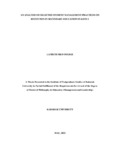| dc.description.abstract | One of the education policies of the government of Kenya according to the Basic
Education act of 2013 is the provision of free and compulsory basic education with the
anticipated target of achieving universal secondary education. The policy of 100%
transition rate from primary to secondary education was instituted to facilitate this
target. However, as transition rates keep improving, student retention has remained low
in Public Secondary Schools in Kisii County. Failure to retain students in schools
implies failure of the government in achieving universal secondary education besides
being considered as a waste of potential human, time and financial resources. The
purpose of the study was to do an analysis of Selected Student Management Practices
on Retention in Secondary Education in Kisii County. The objectives of the study were
to investigate the relationship between student motivation, safety, feeding, instruction
and discipline practices and retention of Students in Public Secondary Schools in Kisii
County. The study was guided by Vroom’s expectancy and McGregor’s X and Y
theories. A conceptual framework involving the variables under investigation was
drawn. Correlational research design was used in this study. A sample of 35 Public
Secondary Schools was selected for the study using Multi-stage sampling technique.
The study sample was 525 respondents comprised of 420 students, 35 Deputy
Principals, 35 Principals and 35 Head Cooks. Questionnaires, interview schedules and
document analysis were used in data collection. Experts in the area under study did
validation of the instruments. A pilot test of the instruments was conducted in Schools
in Nyamira County. Reliability of the instruments was tested using split-half technique
and Spearman-Brown prophecy formula. A coefficient of 0.8 in both the students’ and
Deputy Principals’ questionnaires was obtained. Ethical considerations were employed
throughout the study. Quantitative data was analysed using descriptive and inferential
statistics. Qualitative data was analysed thematically. The statistical package for social
sciences (SPSS) version 25.0 was used to analyse the data. The study findings showed
that there was a strong and positive correlation between student motivation practices
(r=.717), safety practices (r=.689), feeding practices (r=.684), instruction practices
(r=.844), discipline practices (r=.778) and student retention in public secondary schools
in Kisii County. The correlation was statistically significant at 0.05 alpha level.
Regression analysis showed that 63.7% of variations in the student retention were
predictable from student motivation, safety, instructional and discipline practices.
Therefore, it was concluded that, in order to improve student retention rates, school
administrators should practice good student motivation, safety, instructional and
discipline practices. This study was significant because its findings provided school
administrators and education policy makers with knowledge on the best student
management practices that could improve student retention to the anticipated target of
100%. The recommendation of the study was that; the Government should strengthen
student motivation and safety practices, closely monitor curriculum delivery in schools
and provide alternative ways of handling student discipline issues in schools. | en_US |

